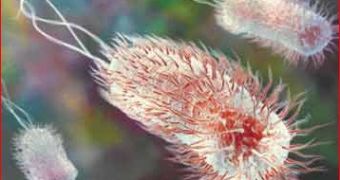Vehicles can vary from the size of a train to that of a ...bacterium.
A team at Emory University has created a novel way of controlling the movement of the bacterium Escherichia coli in a chemical environment, opening the opportunity for new enhanced drug delivery, environmental cleanup and synthetic biology.
The research team which included Dr. Justin Gallivan, assistant professor of chemistry, and graduate student Shana Topp has managed to reprogram E. coli's chemo-navigational system to track down, follow and precisely locate certain chemical signals and compounds.
The bacterium's natural ability to move towards specific chemical compounds in its environment is called chemotaxis. "Equipping bacteria with a way to degrade pollutants, synthesize and release therapeutics, or transport chemicals with an ability to localize to a specific chemical signal would open new frontiers in environmental cleanup, drug delivery and synthetic biology," said Gallivan.
E. coli was equipped with a "riboswitch," a RNA stretch that shifts shape when attached to certain small target molecules, able to activate or disable genes. Other self-propelled chemo-navigating bacterial species, too, could be equipped with the riboswitch to head them towards targeted areas. The chemotactic bacteria move through their environments by connecting their sensory information to powerful, tiny molecular motors located in their flagella that propel the cell forward.
Scientists had been planning the bacterial reprogramming for quite some time now, so that bacteria synthesizing an anti-cancer drug, for instance, would attack ill cells while avoiding side effects on the healthy ones.
Researchers are also investigating ways of using bacteria against contamination, like cleaning up oil spills or removing contaminants from soil, water and wastewater. "This new ability to equip motile bacteria with a precise and tunable chemo-navigation system will greatly enhance the impressive arsenal of natural and engineered cell behaviors," Gallivan said.

 14 DAY TRIAL //
14 DAY TRIAL //